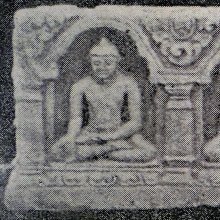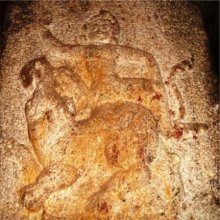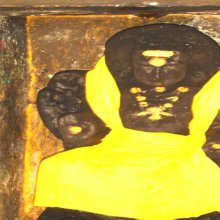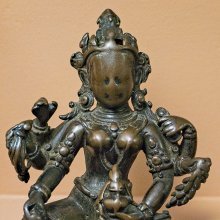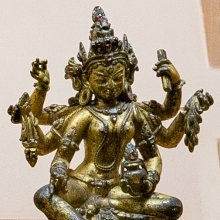Mudras, Mudrās: 1 definition
Introduction:
Mudras means something in Hinduism, Sanskrit. If you want to know the exact meaning, history, etymology or English translation of this term then check out the descriptions on this page. Add your comment or reference to a book if you want to contribute to this summary article.
Images (photo gallery)
(+12 more images available)
In Hinduism
Purana and Itihasa (epic history)
Source: archive.org: Puranic EncyclopediaMudrās (मुद्रास्).—When he recites the mantras a Māntrika should use different kinds of gestures with his hands to suit the recital. They are called Mudrās. The Mudrās in general are given below:
The first mudrā is called Añjalimudrā. Añjalī means a cavity formed by folding the hands and joining the open hands together. If the hands thus folded are placed on the breast it becomes a Vandinī mudrā. The hands should be placed on the breast with a slight slant to the left for Vandinī mudrā. The third mudrā is called Ūrddhva mudrā. Hold the left hand first in such a way that the thumb comes on the top and then with the fingers of the right hand bind the thumb of the left hand. The thumb of the right hand should also come to the top. This is called Ūrddhva mudrā. The lowering of the left palm opened up is called Varāhamudrā. (Chapter 26, Agni Purāṇa).

The Purana (पुराण, purāṇas) refers to Sanskrit literature preserving ancient India’s vast cultural history, including historical legends, religious ceremonies, various arts and sciences. The eighteen mahapuranas total over 400,000 shlokas (metrical couplets) and date to at least several centuries BCE.
See also (Relevant definitions)
Starts with: Mudrasa, Mudrasada, Mudrasamadhi, Mudrasara, Mudrashakti, Mudrashastra, Mudrasphiti, Mudrasphiti, Mudrasphota, Mudrasthana.
Ends with: Saptasamudras.
Full-text (+533): Mudra, Dhenumudra, Shankhamudra, Gadamudra, Padmamudra, Yonimudra, Pancamudra, Alapallava, Mahamudra, Samnirodhani, Samkalikarani, Vanamalamudra, Avahani, Shrivatsamudra, Sammukhikarani, Garudamudra, Vanamala, Kaustubhamudra, Sthani, Samnidhikarani.
Relevant text
Search found 51 books and stories containing Mudras, Mudrās; (plurals include: Mudrases, Mudrāses). You can also click to the full overview containing English textual excerpts. Below are direct links for the most relevant articles:
The Devi Bhagavata Purana (by Swami Vijñanananda)
Chapter 2 - On the description of the Śaktis, etc., of the syllables of Gāyatrī < [Book 12]
Chapter 17 - On the description of Sandhyā and other daily practices < [Book 11]
Chapter 1 - On what is to be thought of in the morning < [Book 11]
Guhyagarbha Tantra (with Commentary) (by Gyurme Dorje)
Text 17.8 (Commentary) < [Chapter 17 (Text And Commentary)]
Chapter 17 - Revelation of the Maṇḍala of Wrathful Deities < [Chapter 17 (Text And Commentary)]
Text 11.6 (Commentary) < [Chapter 11 (Text and Commentary)]
The Indian Buddhist Iconography (by Benoytosh Bhattachacharyya)
Figure 17 - Buddha in different Mudrās (Nalanda)
Figure 18 - Buddha in different Mudrās (Java)
Parama Samhita (English translation) (by Krishnaswami Aiyangar)
Cidgaganacandrika (study) (by S. Mahalakshmi)
Verse 73 [Guru Parampara, Pūjā and Mudrās] < [Chapter 2 - Second Vimarśa]
Verse 147 [Spread of Vṛndacakra] < [Chapter 3 - Third Vimarśa]
Verse 74 [Śakti Prabhāva] < [Chapter 2 - Second Vimarśa]
Samarangana-sutradhara (Summary) (by D. N. Shukla)
Related products
.jpg)
